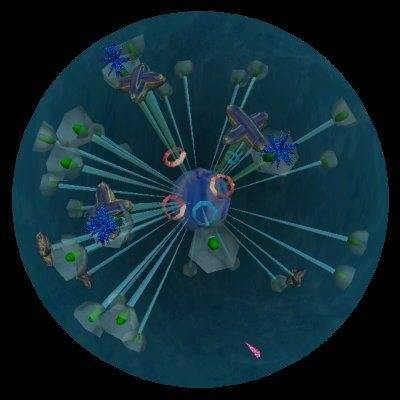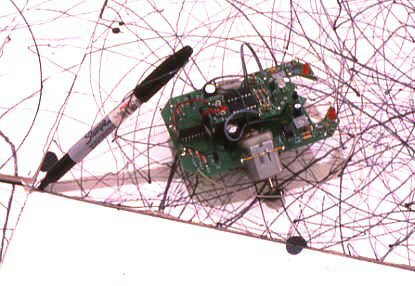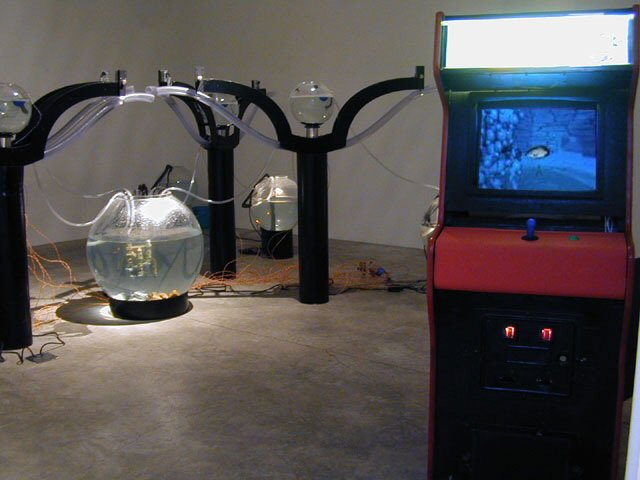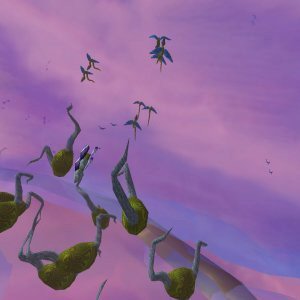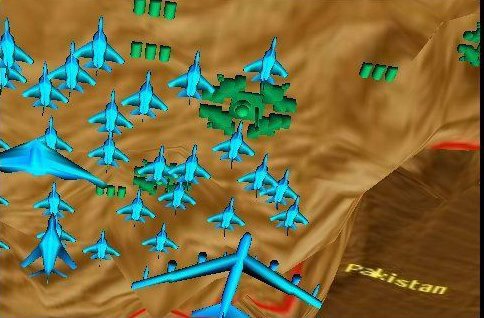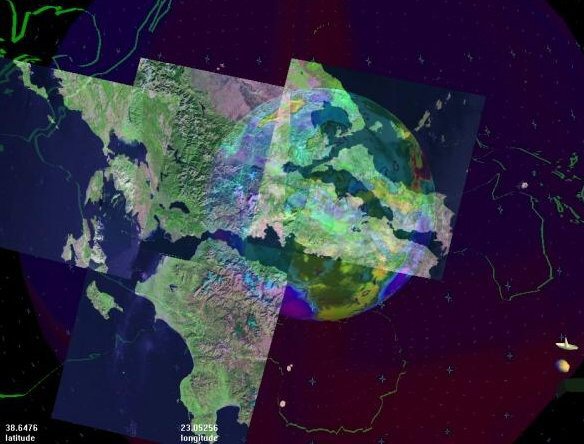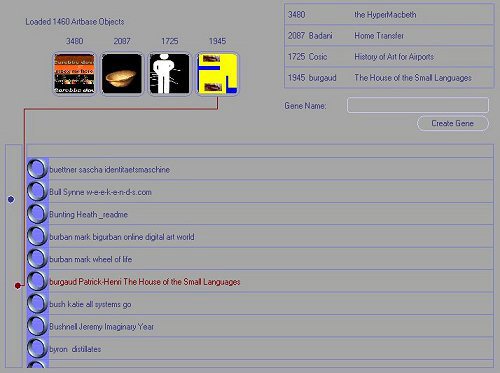Please wait a few moments while we process your request

John Klima
(Brooklyn, New York, United States)
John Klima lives and works in Brooklyn. He holds a bachelor of fine arts degree from the State University of New York at Purchase. After working for major computer firms like Microsoft, Klima decided to devote his time to creating complex interactive environments using the knowledge he’d acquired on the job. His first attempts at Web art were saluted by the 3-D animation community. His work has been presented at prestigious festivals worldwide, including Viper: International Festival for Film Video and New Media (Lucerne, Switzerland) in 1999.
Thanks to Glasbead (2000) (1), winner of the Golden Lasso Award for Art at SIGGRAPH 2000 (New Orleans, Louisiana, U.S.A.), Klima has become a leading light in the new generation of Web artists. This work is an interactive game whose interface is a rotating sphere filled with sound files. By accessing these files, viewers create myriad soundscapes that grow increasingly complex as more viewers enter the on-line environment.
Many Klima projects merge video game interfaces with robots controlled in real time by the viewer. In a 2001 solo exhibition held at the gallery Postmasters (New York, New York, U.S.), two works combined physical and virtual spaces with a clear causal relationship between these spaces.
Go (2000), inspired by a Japanese game of the same name, consists of a 16 foot by 24 foot map that represents international currencies and a console that controls both the 3-D environment and the installation’s robots. Equipped with special pens, the robots travel across the game board leaving behind trails akin to Jackson Pollock drippings. This 3-D game’s interface, the spinning earth, is projected onto a weather balloon. The robots aren’t remote-controlled but operate through voltage currents. When their batteries run low, they head to recharging stations located at strategic spots on the game board, which the player can identify with eight host countries. The size of glowing circles in the 3-D environment fluctuates with the stock market. When the market is volatile, the circles grow. The aim of the game: to drag small satellites into these circles using a joystick so as to turn the recharging stations on and off. Though the robots’ paths reflect the fluctuating stock market, they’re also determined by the player’s actions. Ultimately, Go introduces some free will into systems like the stock market and the economy that seem to operate in total seclusion.
Fish (2001), which also appeared in the Postmasters exhibit, is a combination video arcade game and interactive installation. Players must lead their virtual goldfish through a labyrinth of predator-infested waters and toward a safe zone. If their fish makes it to safety, a live goldfish is released from a holding tank into an aquarium with other fish saved by other players. If players fail, however, their fish becomes a real predator’s lunch. This sacrifice of a real goldfish demonstrates the metaphorical hold of the virtual over the real.
In Ecosystm (2001), which was presented during the BitStreams exhibition at the Whitney Museum of American Art (New York, New York, U.S.A.) (2) in 2001, Klima maps systems made up of randomly structured data sets. This 3-D animated work simultaneously showcases changes in global currency, stock markets and weather conditions at John F. Kennedy Airport. The work presents an allegorical commentary on data used for updating information. To illustrate the ups and downs in the economy, Klima has chosen not abstract imagery but rather an analogue system born out of the natural world. The 3-D animation consists of flocks of birds flying near a forest. Each flock stands for a country’s currency and is linked to a tree structure representing the country’s leading market index. When the market fluctuates, tree branches fall off and the birds scatter erratically. The biological balance of the flocks therefore depends on the market’s economic stability. This work, which was commissioned by the New York investment firm Zurich Capital Markets, recycles the data the firm uses to carry out daily transactions.
Like Serbian Skylight (1999), Klima’s first foray into the world of war games, The Great Game (2001) uses an interface that generates a 3-D model from data collected on the Internet. The Java application runs 3-D animation representing a terrain map of Afghanistan at the start of the recent conflict. Since October 7, 2001, Klima has been perusing the U.S. defence department’s strategic planning reports and transferring the data to his map. To represent planes, munitions and manpower, he recycles the icons used as pictograms in video war games. Though initially clear, the region gradually fills with icons evoking the West’s military strategies aimed at toppling the Taliban regime. The basis for this work and its mode of display reflect the partial coverage of the event. Since how we visualize news events depends on information available publicly at a precise moment, the resulting image is always deceptive. Unlike video games where players can alter the action, here they are passive observers of the developing stranglehold on the region.
EARTH (2001), an installation shown at the biennial of the Whitney Museum of American Art (New York, New York, U.S.A.) in 2002, presents a relationship with mapmaking that is less overtly political. A software places data from geological surveys, satellites and U.S. government sites onto a 3-D model of the Earth. These data are shown to viewers as stratified layers. Using a cursor, viewers manipulate the interface and travel through the levels on the surface of the globe. The first layer shows the outline of coastal regions. Also featured is a satellite image in which viewers can isolate a portion of a region to retrieve information on local weather conditions. In the version of the work presented at the Whitney Biennial, a weather balloon displayed data. By using this device, Klima explored a new trend in on-line art (closer to installation practices) whereby a Web page’s preformatted frame isn’t the only context for experiencing a work.
EARTH investigates our tendency to use a portion of available information to formulate opinions that seem to encompass an entire phenomenon. As a follow-up to EARTH, Klima has developed Terrain Machine, an installation that draws on topographic data collected by the satellite Landsat-7 and other landmarking tools to represent the terrain as an adjustable portion of the territory. Finally, since 2002, Klima has been designing a new interface for the Rhizome Artbase search engine. Known as Context Breeder, (3) this interface sets up a chain of meaningful links between the sequences of objects that each user creates when making a request. Besides pursuing Klima’s research into network modelling, Context Breeder helps us visualize the subjective characteristics specific to users of an on-line database.
Many Klima projects merge video game interfaces with robots controlled in real time by the viewer. In a 2001 solo exhibition held at the gallery Postmasters (New York, New York, U.S.), two works combined physical and virtual spaces with a clear causal relationship between these spaces.
Go (2000), inspired by a Japanese game of the same name, consists of a 16 foot by 24 foot map that represents international currencies and a console that controls both the 3-D environment and the installation’s robots. Equipped with special pens, the robots travel across the game board leaving behind trails akin to Jackson Pollock drippings. This 3-D game’s interface, the spinning earth, is projected onto a weather balloon. The robots aren’t remote-controlled but operate through voltage currents. When their batteries run low, they head to recharging stations located at strategic spots on the game board, which the player can identify with eight host countries. The size of glowing circles in the 3-D environment fluctuates with the stock market. When the market is volatile, the circles grow. The aim of the game: to drag small satellites into these circles using a joystick so as to turn the recharging stations on and off. Though the robots’ paths reflect the fluctuating stock market, they’re also determined by the player’s actions. Ultimately, Go introduces some free will into systems like the stock market and the economy that seem to operate in total seclusion.
Fish (2001), which also appeared in the Postmasters exhibit, is a combination video arcade game and interactive installation. Players must lead their virtual goldfish through a labyrinth of predator-infested waters and toward a safe zone. If their fish makes it to safety, a live goldfish is released from a holding tank into an aquarium with other fish saved by other players. If players fail, however, their fish becomes a real predator’s lunch. This sacrifice of a real goldfish demonstrates the metaphorical hold of the virtual over the real.
In Ecosystm (2001), which was presented during the BitStreams exhibition at the Whitney Museum of American Art (New York, New York, U.S.A.) (2) in 2001, Klima maps systems made up of randomly structured data sets. This 3-D animated work simultaneously showcases changes in global currency, stock markets and weather conditions at John F. Kennedy Airport. The work presents an allegorical commentary on data used for updating information. To illustrate the ups and downs in the economy, Klima has chosen not abstract imagery but rather an analogue system born out of the natural world. The 3-D animation consists of flocks of birds flying near a forest. Each flock stands for a country’s currency and is linked to a tree structure representing the country’s leading market index. When the market fluctuates, tree branches fall off and the birds scatter erratically. The biological balance of the flocks therefore depends on the market’s economic stability. This work, which was commissioned by the New York investment firm Zurich Capital Markets, recycles the data the firm uses to carry out daily transactions.
Like Serbian Skylight (1999), Klima’s first foray into the world of war games, The Great Game (2001) uses an interface that generates a 3-D model from data collected on the Internet. The Java application runs 3-D animation representing a terrain map of Afghanistan at the start of the recent conflict. Since October 7, 2001, Klima has been perusing the U.S. defence department’s strategic planning reports and transferring the data to his map. To represent planes, munitions and manpower, he recycles the icons used as pictograms in video war games. Though initially clear, the region gradually fills with icons evoking the West’s military strategies aimed at toppling the Taliban regime. The basis for this work and its mode of display reflect the partial coverage of the event. Since how we visualize news events depends on information available publicly at a precise moment, the resulting image is always deceptive. Unlike video games where players can alter the action, here they are passive observers of the developing stranglehold on the region.
EARTH (2001), an installation shown at the biennial of the Whitney Museum of American Art (New York, New York, U.S.A.) in 2002, presents a relationship with mapmaking that is less overtly political. A software places data from geological surveys, satellites and U.S. government sites onto a 3-D model of the Earth. These data are shown to viewers as stratified layers. Using a cursor, viewers manipulate the interface and travel through the levels on the surface of the globe. The first layer shows the outline of coastal regions. Also featured is a satellite image in which viewers can isolate a portion of a region to retrieve information on local weather conditions. In the version of the work presented at the Whitney Biennial, a weather balloon displayed data. By using this device, Klima explored a new trend in on-line art (closer to installation practices) whereby a Web page’s preformatted frame isn’t the only context for experiencing a work.
EARTH investigates our tendency to use a portion of available information to formulate opinions that seem to encompass an entire phenomenon. As a follow-up to EARTH, Klima has developed Terrain Machine, an installation that draws on topographic data collected by the satellite Landsat-7 and other landmarking tools to represent the terrain as an adjustable portion of the territory. Finally, since 2002, Klima has been designing a new interface for the Rhizome Artbase search engine. Known as Context Breeder, (3) this interface sets up a chain of meaningful links between the sequences of objects that each user creates when making a request. Besides pursuing Klima’s research into network modelling, Context Breeder helps us visualize the subjective characteristics specific to users of an on-line database.
Vincent Bonin © 2002 FDL


